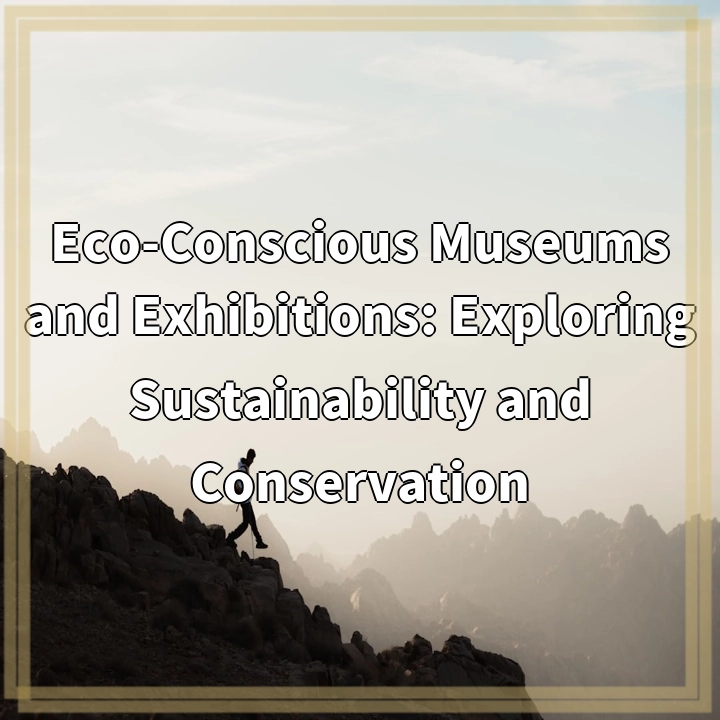Physical Address
304 North Cardinal St.
Dorchester Center, MA 02124
Physical Address
304 North Cardinal St.
Dorchester Center, MA 02124

Eco-conscious museums and exhibitions are innovative initiatives within the cultural sphere that focus on promoting sustainability, conservation, and environmental awareness. These venues aim to educate, inspire, and engage visitors in a dialogue about the importance of protecting the environment and fostering a more sustainable future. They go beyond simply displaying artifacts or artworks; instead, they integrate principles of environmental responsibility into every aspect of their operations.
While eco-conscious museums and exhibitions play a vital role in advocating for environmental conservation and sustainability, they also face several challenges and concerns.
Eco-conscious museums and exhibitions often require significant financial investments to implement sustainability initiatives, such as energy-efficient technologies, renewable energy systems, and waste management infrastructure. Seeking partnerships with government agencies, private donors, and environmental organizations that align with the mission of sustainability can help address funding challenges. Additionally, applying for grants specifically targeted toward eco-conscious initiatives can provide the necessary financial support. Implementing cost-saving measures, such as energy-efficient lighting and water conservation practices, can also help overcome funding constraints.
Ensuring the preservation of artistic and cultural artifacts while still allowing public access can be a delicate balance. High foot traffic and exposure to light, temperature, and humidity within museums and exhibitions can impact the longevity of delicate pieces. To address this challenge, advanced technologies like climate-controlled display cases, light-filtering materials, and innovative storage systems can be utilized. These measures minimize the impact on artifacts while ensuring public access. Visitor education programs can also play a role in raising awareness about the importance of responsible viewing and handling.
Reaching diverse audiences and capturing their interest in environmental issues can be a challenge. Museums and exhibitions need to develop innovative and engaging ways to communicate their sustainability messages to a broad range of visitors, regardless of age, cultural background, or prior knowledge. Creating interactive and immersive experiences that cater to a wide range of interests and learning styles can help engage diverse audiences. Developing educational materials and programs that are culturally sensitive and address the specific concerns of different communities is also crucial. Collaborating with local schools, community centers, and organizations can further expand the reach and impact of these initiatives.
Eco-conscious museums and exhibitions need to ensure that their supply chains align with sustainable principles. This involves sourcing environmentally friendly materials for construction, exhibitions, and merchandise, as well as supporting fair trade practices. Sourcing materials from eco-friendly suppliers and prioritizing sustainability in exhibit designs is essential for supply chain management. Additionally, focusing on recycling, upcycling, and minimizing waste throughout the supply chain can promote sustainability. Emphasizing the use of locally sourced and organic products in cafes and gift shops can further support sustainable practices.
Quantifying the impact and effectiveness of eco-conscious museums and exhibitions in terms of raising awareness, inspiring behavior change, and fostering sustainability can be challenging. Developing comprehensive evaluation frameworks to assess the impact of sustainability initiatives is crucial. Engaging in data collection and analysis can track visitor feedback, behavior change, and environmental outcomes. Sharing success stories and best practices with the wider community can inspire others and generate support. Continuous evaluation and improvement are necessary to justify investments and ensure the ongoing success of these initiatives.
In conclusion, while eco-conscious museums and exhibitions face various real-world challenges, they are crucial in promoting sustainability, conservation, and environmental awareness. By addressing funding and resource constraints, balancing conservation and accessibility, engaging diverse audiences, implementing sustainable supply chain management, and measuring impact and effectiveness, these venues can continue to make a significant positive impact on both local and global scales.
1. Funding and Resources:
– Seek partnerships with government agencies, private donors, and environmental organizations that align with the mission of sustainability.
– Apply for grants specifically targeted toward eco-conscious initiatives.
– Implement cost-saving measures such as energy-efficient lighting and water conservation practices.
2. Balancing Conservation and Accessibility:
– Utilize advanced technologies like climate-controlled display cases, light-filtering materials, and innovative storage systems.
– Implement visitor education programs to raise awareness about the importance of responsible viewing and handling.
3. Engaging Diverse Audiences:
– Create interactive and immersive experiences that cater to a wide range of interests and learning styles.
– Develop educational materials and programs that are culturally sensitive and address the specific concerns of different communities.
– Collaborate with local schools, community centers, and organizations to reach a broader audience.
4. Supply Chain Management:
– Source materials from eco-friendly suppliers and exhibit designs that prioritize sustainability.
– Focus on recycling, upcycling, and minimizing waste throughout the supply chain.
– Emphasize the use of locally sourced and organic products in cafes and gift shops.
5. Measuring Impact and Effectiveness:
– Develop comprehensive evaluation frameworks to assess the impact of sustainability initiatives.
– Engage in data collection and analysis to track visitor feedback, behavior change, and environmental outcomes.
– Share success stories and best practices with the wider community to inspire others and generate support.
By implementing these solutions, eco-conscious museums and exhibitions can overcome real-world challenges and continue to lead the way in promoting sustainability, conservation, and environmental awareness.
If you’re wondering where the article came from!
#